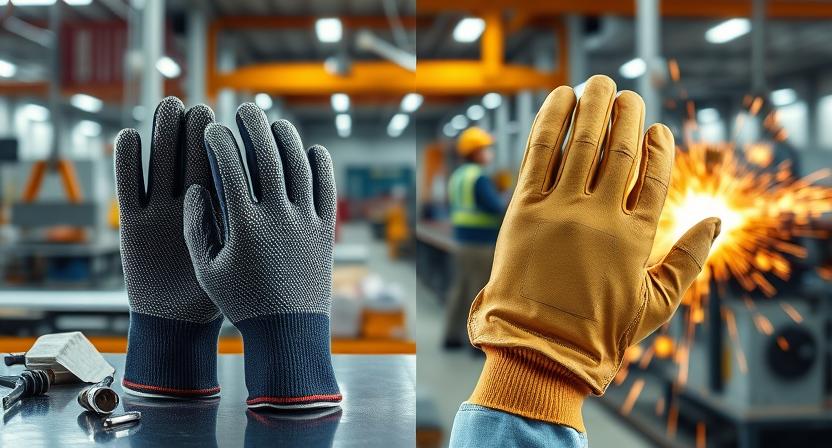Cut-Resistant vs. Heat-Resistant Gloves: Which One Does Your Industry Need?

🧤 Introduction: Why Choosing the Right Industrial Gloves Matters
When it comes to industrial safety, one size does not fit all—especially for hand protection. Whether you’re handling sharp metals or working near molten surfaces, using the wrong type of glove can lead to serious injuries.
In this guide, we’ll compare cut-resistant gloves vs. heat-resistant gloves, highlight their benefits, applications, and help you decide which one is right for your industry in 2025.
🔪 What Are Cut-Resistant Gloves?
Cut-resistant gloves are designed to protect hands from sharp tools, blades, glass, and metal sheets. They’re typically made from high-performance fibers like Kevlar®, HPPE, or stainless steel mesh.
✅ Key Features:
Made from cut-proof materials (Kevlar, Dyneema, glass fiber)
Often lightweight yet highly durable
Some include coatings for grip (PU, nitrile, latex)
🏭 Industries That Use Cut-Resistant Gloves:
Metal fabrication
Automotive manufacturing
Glass handling
Construction
Warehousing
🔥 What Are Heat-Resistant Gloves?
Heat-resistant gloves are built to shield hands from extreme temperatures, flames, and sparks. They are commonly crafted using leather, aluminized materials, and thermal linings.
✅ Key Features:
Withstand high temperatures up to 1500°F+ (depending on material)
Often include flame-retardant properties
Provide insulation for prolonged exposure to heat
🏭 Industries That Use Heat-Resistant Gloves:
Welding and metal forging
Glass blowing
Foundries and steel plants
Food processing (bakeries, ovens)
Electrical and thermal work
⚖️ Cut-Resistant vs. Heat-Resistant Gloves: Side-by-Side Comparison
| Feature | Cut-Resistant Gloves | Heat-Resistant Gloves |
|---|---|---|
| Primary Protection | Against cuts, slashes, abrasion | Against heat, fire, thermal burn |
| Material | HPPE, Kevlar, steel mesh | Leather, aluminized fabrics |
| Use Cases | Sharp tools, glass, metals | Welding, furnace, heat handling |
| Dexterity | High | Moderate |
| Heat Resistance | Low to none | High |
| Cut Resistance | High | Low |
🧩 Which One Does Your Industry Need?
Choosing between cut-resistant and heat-resistant gloves depends on your workplace hazards:
✅ Use Cut-Resistant Gloves if you’re exposed to:
Sharp tools, glass, sheet metal
Repetitive slicing or handling of jagged parts
🔥 Use Heat-Resistant Gloves if you’re exposed to:
High temperatures, sparks, or flames
Welding, oven work, or foundry tasks
For dual protection, hybrid gloves are available with both cut and heat resistance—ideal for complex industrial environments.
👷 Expert Tip: Don’t Compromise on Glove Ratings
Always check the ANSI/EN388 (cut resistance) and ASTM/EN407 (heat resistance) ratings before purchasing. The right glove not only boosts safety but also enhances worker confidence and productivity.
🏁 Final Verdict: Safety Starts with Smart Choices
Whether it’s a sharp blade or burning metal, your hands are your most valuable tools. Choosing between cut-resistant and heat-resistant gloves should be based on a clear understanding of hazards, industry standards, and work environment.
Invest in the right gloves today—and reduce injuries, downtime, and costs tomorrow.
FAQs: Cut vs. Heat Resistant Gloves
Can I use cut-resistant gloves for welding?
No. Cut-resistant gloves do not provide protection against heat or flame. Always use certified heat-resistant gloves for welding.
Are there gloves that offer both cut and heat resistance?
Yes. Some gloves are designed with dual-layered protection for industries exposed to both risks.
Which industries require the highest cut resistance?
Glass manufacturing, metal stamping, and recycling centers usually require the highest levels of cut resistance.
📈 Optimize Your Safety Gear with Spectrum Technicals
Looking for high-performance cut-resistant or heat-resistant gloves for your team?
👉 Explore Spectrum Technicals’ latest PPE range for 2025 – built for safety, comfort, and compliance.
📥 Download Our Free Hand Protection Guide (PDF)
Get our expert-approved guide to choosing the right safety gloves for your industry.
[Download Now] – Just expert insights.
